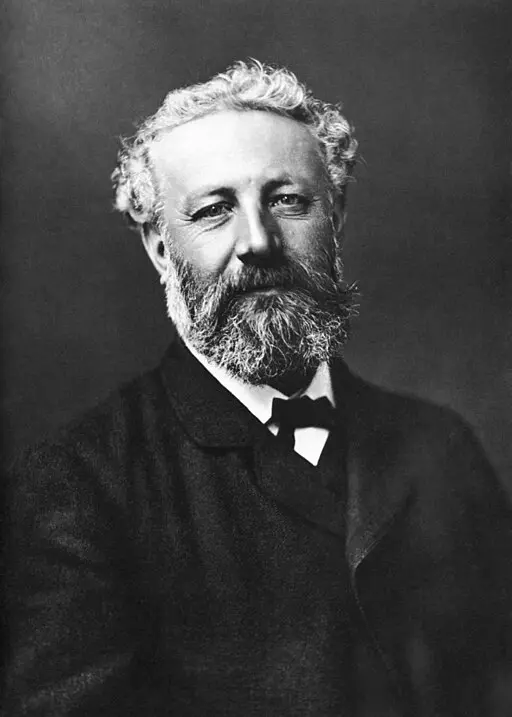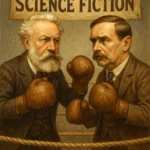Jules Verne (1828–1905)
The Visionary of Science Fiction
Jules Verne is celebrated as a pioneer of science fiction, blending real science with daring adventures that captured the imagination of readers and inventors alike. His stories anticipated technologies far ahead of his time—advanced submarines, space capsules, even video calls—while conveying both the wonder of discovery and the promise of human ingenuity. This unique blend of bold imagination and scientific rigor made him a founding father of the genre.
Biography in Brief
- Born: February 8, 1828 — Nantes, France
- Died: March 24, 1905 — Amiens, France
- Nationality: French
Born in Nantes, France, in 1828, Verne grew up near the docks, where he developed a fascination with ships, exploration, and the wider world. Though initially steered toward a career in law, his passion for writing prevailed, and he soon began publishing stories that combined adventure with science.
His career took off in 1863 with Five Weeks in a Balloon, the first in a long-running series of Voyages extraordinaires (Extraordinary Journeys). Much of this ambitious project’s success was due to his long-time collaboration with publisher Pierre-Jules Hetzel. Hetzel encouraged Verne’s blend of education and adventure, shaping the optimistic and scientific tone that defined the series.
Verne authored 54 novels in this series, along with short stories and other works, totaling nearly 70 publications. He became not just a novelist but a cultural figure, with his works translated around the globe. He lived to see many of his books adapted for stage and early cinema, ensuring his influence would endure long after his death.
Key Sci-Fi Works
- Journey to the Center of the Earth (1864)
One of Verne’s earliest and most popular works; a subterranean adventure blending geology with imaginative exploration. - From the Earth to the Moon (1865)
An astonishingly accurate vision of space travel; directly inspired early rocket scientists, anticipated lunar missions a century later. - Twenty Thousand Leagues Under the Seas (1870)
Introduced Captain Nemo and the Nautilus submarine, predicting undersea technology and exploring themes of isolation and rebellion. Widely regarded as one of his masterpieces. - Around the World in Eighty Days (1873)
Though more adventure than science fiction, this novel captured how steamships and railways made the world feel smaller through technology. - The Mysterious Island (1874)
A survival tale showcasing scientific ingenuity and technological optimism. - Paris in the Twentieth Century (written 1863, published 1994)
A rare dystopian vision by Verne, portraying a future dominated by technology and finance while art and culture wither away. Rejected by his publisher (Hetzel) for being too bleak, it was rediscovered and published over a century later.
With the exception of Paris in the Twentieth Century, all the above titles were part of the Voyages extraordinaires (Extraordinary Journeys) series.
Contribution to Science Fiction
Verne’s visionary genius lay in imagining technologies far beyond his era. Some ideas were entirely new, others bold extensions of what was just beginning to emerge.
For example, crude submarines and batteries already existed in Verne’s time, but nothing close to what he imagined. His Nautilus in Twenty Thousand Leagues Under the Seas (yes, Seas — plural) was electrically powered, long-ranged, and luxuriously livable. Its fictional sodium-mercury batteries stretched the limits of known science, making the vessel feel both futuristic and plausible. In From the Earth to the Moon, he even foresaw Florida as the perfect launch site — a prediction later echoed by NASA at Cape Canaveral.
He helped establish the tradition of scientific adventure stories, where exploration of Earth, sea, and sky also served as a stage for imagining humanity’s future. His emphasis on invention and discovery gave readers a sense of optimism about human potential — though works like Paris in the Twentieth Century reveal he could also imagine darker futures.
Critics often compare him with H.G. Wells: both were called writers of “scientific romances,” but they used science in different ways. Verne rooted his tales in the technology of his day, turning it into thrilling adventures of exploration and discovery. Wells started from the same foundation but used science to imagine social critique and cautionary futures. Together, they launched two complementary traditions of early science fiction.
Legacy & Influence
Beyond his innovations in storytelling, Verne’s cultural reach was immense. His Extraordinary Voyages rank among the most translated and widely read works in literary history. Dozens of his novels have been adapted for film and television. Some of the most enduring examples include Disney’s 20,000 Leagues Under the Sea (1954), the recent Nautilus TV series (2025), and repeated screen versions of Journey to the Center of the Earth—from the Hollywood classic 1959 film to the blockbuster 2008 version starring Brendan Fraser.
His influence also extended beyond literature. Inventors and scientists often cited Verne as an inspiration, noting how his speculative ideas anticipated real-world advances in submarines, aviation, and space exploration. The Russian rocket pioneer Konstantin Tsiolkovsky, one of the founding fathers of astronautics, was directly inspired by From the Earth to the Moon. Likewise, American engineer Simon Lake, a pioneer of modern submarines, credited Verne’s Nautilus with sparking his lifelong fascination with undersea travel.
Verne’s foresight in imagining technologies long before they existed cemented his place as a central figure in science fiction.
Related Blog Posts
👉 Explore related posts about Jules Verne:
🎤 Sci-Fi fight fans, welcome to tonight’s main event! In the red corner, hailing from Bromley, England… he brought us time travel, invisible men, and Martian war machines… the sharp-eyed pessimist who built frameworks of progress, catastrophe, and consequence… it’s H.G. “The Architect” Wells! And in the blue corner, from Nantes, France… he sent submarines…
Sources & Further Reading
- Verne, Jules. Around the World in Eighty Days (1873)
- Verne, Jules. From the Earth to the Moon (1865)
- Verne, Jules. Journey to the Center of the Earth (1864)
- Verne, Jules. Paris in the Twentieth Century (written 1863, published 1994)
- Verne, Jules. The Mysterious Island (1874)
- Verne, Jules. Twenty Thousand Leagues Under the Seas (1870)
- Angenot, Marc. “Jules Verne and French Literary Criticism,” Science Fiction Studies, No. 1 (1973): A landmark essay analyzing Verne’s place in the French literary canon.
- Butcher, William. Jules Verne: The Definitive Biography (2006): Considered the most authoritative biography, offering a nuanced look at Verne’s life and correcting many misconceptions.
- Encyclopedia Britannica – Jules Verne: A comprehensive overview of Verne’s life, works, and cultural impact.
- Evans, Arthur B. Jules Verne Rediscovered: Didacticism and the Scientific Novel (1988): A seminal work that redefines Verne’s novels as “scientific romances” intended to educate as well as entertain.
- Lottman, Herbert R. Jules Verne: An Exploratory Biography (1996): A detailed exploration of Verne’s life, career, and his complex relationship with publisher Pierre-Jules Hetzel.
- Société Jules Verne (Association, founded 1935): The leading academic society dedicated to Verne scholarship, publisher of the long-running Bulletin de la Société Jules Verne.
- Taves, Brian. Hollywood Presents Jules Verne: The Father of Science Fiction on Screen (2008): A study of how Verne’s works have been adapted and reimagined in film and television.
Frequently Asked Questions
A: Verne earned the title for grounding adventure tales in real science and projecting technologies that often proved prophetic—submarines, space travel, even video communication. Through his Voyages extraordinaires, guided by publisher Pierre-Jules Hetzel, he helped define a new genre of “scientific romance” that inspired both readers and future scientists.
A: His most enduring stories include Journey to the Center of the Earth (1864), From the Earth to the Moon (1865), Twenty Thousand Leagues Under the Seas (1870), Around the World in Eighty Days (1873), and The Mysterious Island (1874). All of these were part of his long-running Voyages extraordinaires series, which was designed to combine education with adventure.
A: Many were strikingly accurate. He described long-range submarines, space capsules, video communication, and elements of modern rocketry decades before they became reality. Other ideas, like launching people to the Moon with a giant cannon, were less practical—but they still captured the imagination of scientists who ultimately made spaceflight a reality.
A: Yes, inventors like Konstantin Tsiolkovsky (rocketry) and Simon Lake (submarines) cited Verne’s novels as direct inspirations, showing how his imaginative ideas spurred real innovation.
A: Verne wrote the novel in 1863, before his career took off. His publisher, Pierre-Jules Hetzel, rejected it for being too bleak, preferring the more optimistic, educational style of Five Weeks in a Balloon (published shortly after). As a result, Paris was shelved and only rediscovered in 1994. Some scholars suggest that, had it been published, Verne’s career might have taken a darker, more dystopian path.
A: Growing up near the docks of Nantes, France, Verne developed a lifelong fascination with ships and exploration, which inspired the adventurous spirit of his novels. His legal studies, though abandoned, gave him a disciplined approach to researching the scientific details that grounded his stories.
Affiliate Disclosure: Some links on this page are affiliate links. If you click through and make a purchase, Founders of Sci-Fi may earn a small commission—at no extra cost to you. Thanks for supporting the site!

